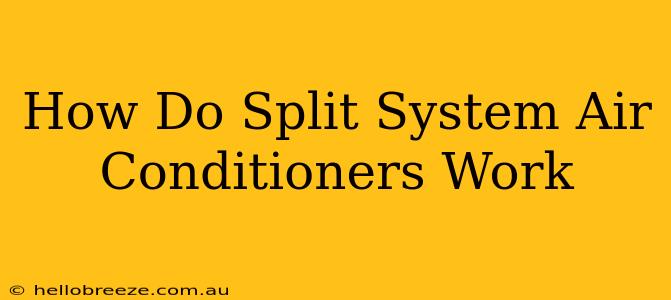Split system air conditioners are the most common type of air conditioning found in homes and businesses today. But how do they actually work? Understanding the process can help you better maintain your system and appreciate its efficiency. This guide breaks down the mechanics of a split system AC, explaining each component and its role in cooling your space.
Understanding the "Split"
The name "split system" refers to the physical separation of the air conditioner into two main units:
- The Outdoor Unit (Condenser): This unit sits outside your home and contains the compressor, condenser coils, and fan. It's responsible for releasing heat absorbed from inside your home.
- The Indoor Unit (Evaporator): Located inside, this unit houses the evaporator coils, blower fan, and air filter. It circulates cool air throughout your living space.
These two units are connected by refrigerant lines, allowing the refrigerant to travel between them, carrying heat with it.
The Refrigeration Cycle: A Step-by-Step Guide
The magic of a split system AC lies in its refrigeration cycle. This cyclical process involves four key stages:
1. Evaporation (Inside Unit):
The refrigerant, a special liquid that easily absorbs and releases heat, enters the indoor unit as a low-pressure, low-temperature liquid. It flows through the evaporator coils, absorbing heat from the air circulating around them. This causes the refrigerant to evaporate, turning into a low-pressure, low-temperature gas. The now-cooled air is blown into your room by the indoor unit's fan.
2. Compression (Outdoor Unit):
The refrigerant gas then travels through the refrigerant lines to the compressor in the outdoor unit. The compressor increases the pressure and temperature of the gas, turning it into a high-pressure, high-temperature gas. This is where a significant amount of energy is used.
3. Condensation (Outdoor Unit):
The high-pressure, high-temperature gas flows through the condenser coils in the outdoor unit. These coils are exposed to the outside air, allowing the heat to dissipate into the atmosphere. This causes the refrigerant to condense back into a high-pressure, high-temperature liquid.
4. Expansion (Outdoor Unit):
Finally, the high-pressure liquid refrigerant passes through an expansion valve. This valve reduces the pressure of the refrigerant, converting it back into a low-pressure, low-temperature liquid, ready to begin the cycle again in the evaporator coil inside your home.
Key Components and Their Functions
Let's delve deeper into the crucial components:
- Compressor: The heart of the system, responsible for raising the refrigerant's pressure and temperature. Its efficiency directly impacts the overall energy consumption of the AC.
- Condenser Coils: Located in the outdoor unit, these coils release the heat absorbed from the indoor air. Proper cleaning and maintenance of these coils are essential for optimal performance.
- Evaporator Coils: Located in the indoor unit, these coils absorb heat from the indoor air, cooling it down. Keeping these coils clean prevents performance issues.
- Blower Fan (Indoor Unit): Circulates the cooled air throughout your space. A malfunctioning blower fan can drastically reduce cooling effectiveness.
- Refrigerant: The working fluid that carries heat from inside to outside. It's crucial to avoid leaks and maintain the proper refrigerant charge.
Maintaining Your Split System AC
Regular maintenance is key to ensuring your split system air conditioner runs efficiently and lasts longer. This includes:
- Cleaning air filters regularly: Clogged filters restrict airflow and reduce cooling capacity.
- Inspecting and cleaning condenser and evaporator coils: Clean coils improve heat transfer and prevent damage.
- Scheduling annual professional maintenance: A technician can identify and address potential issues before they become major problems.
By understanding how your split system air conditioner works, you can better appreciate its functionality, troubleshoot minor problems, and ensure its longevity. Remember, regular maintenance is key to optimal performance and energy efficiency!

